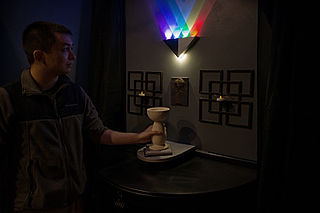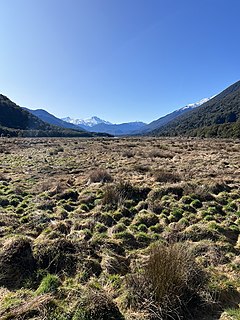
The Leaning Tower of Pisa, or simply, the Tower of Pisa, is the campanile, or freestanding bell tower, of Pisa Cathedral. It is known for its nearly four-degree lean, the result of an unstable foundation. The tower is one of three structures in the Pisa's Cathedral Square, which includes the cathedral and Pisa Baptistry.

Within visual perception, an optical illusion is an illusion caused by the visual system and characterized by a visual percept that arguably appears to differ from reality. Illusions come in a wide variety; their categorization is difficult because the underlying cause is often not clear but a classification proposed by Richard Gregory is useful as an orientation. According to that, there are three main classes: physical, physiological, and cognitive illusions, and in each class there are four kinds: Ambiguities, distortions, paradoxes, and fictions. A classical example for a physical distortion would be the apparent bending of a stick half immerged in water; an example for a physiological paradox is the motion aftereffect. An example for a physiological fiction is an afterimage. Three typical cognitive distortions are the Ponzo, Poggendorff, and Müller-Lyer illusion. Physical illusions are caused by the physical environment, e.g. by the optical properties of water. Physiological illusions arise in the eye or the visual pathway, e.g. from the effects of excessive stimulation of a specific receptor type. Cognitive visual illusions are the result of unconscious inferences and are perhaps those most widely known.

Alton Towers Resort is a theme park and resort complex in Staffordshire, England, near the village of Alton. The park is operated by Merlin Entertainments Group and incorporates a theme park, water park, spa, mini golf and hotel complex.

Wānaka is a popular ski and summer resort town in the Otago region of the South Island of New Zealand. At the southern end of Lake Wānaka, it is at the start of the Clutha River/Mata-Au and is the gateway to Mount Aspiring National Park.

Mount Aspiring National Park is in the Southern Alps of the South Island of New Zealand, north of Fiordland National Park, situated in Otago and Westland regions. The park forms part of the Te Wahipounamu World Heritage site.

Camera Obscura & World of Illusions is a tourist attraction located in Outlook Tower on the Castlehill section of the Royal Mile close to Edinburgh Castle. The original attraction was founded by entrepreneur Maria Theresa Short in 1835 and was exhibited on Calton Hill. Outlook Tower has been a museum since the late 1890s and is currently home to many interactive exhibits, including the original Camera Obscura.
Archimedes-lab.org is a free and collaborative edutainment project developed and maintained by Gianni A. Sarcone and Marie-Jo Waeber, two authors and writers with more than thirty years of experience in the fields of visual thinking and education. This educational project is part of the Open Education Consortium and it is supervised by a consulting network of experts specializing in online education.
Eric Harshbarger is an Alabama-based builder of large-scale Lego brick mosaics and sculptures. From around 2000 to 2006 he was commissioned to build for television shows and magazines for promotional purposes.

NZ Skeptics is a New Zealand incorporated society created in 1986, with the aim of promoting critical thinking. The main areas of interest to the NZ Skeptics are claims of psychic abilities, alternative medicine, creationism and other pseudoscientific claims. At its founding in 1986, it was known as the New Zealand Committee for the Scientific Investigation of Claims of the Paranormal (NZCSICOP). In 2007 the name was formally changed to NZ Skeptics Incorporated.

Arts Foundation of New Zealand Te Tumu Toi is a New Zealand arts organisation that supports artistic excellence and facilitates private philanthropy through raising funds for the arts and allocating it to New Zealand artists.
The One Million Dollar Paranormal Challenge was an offer by the James Randi Educational Foundation (JREF) to pay out one million U.S. dollars to anyone who could demonstrate a supernatural or paranormal ability under agreed-upon scientific testing criteria. A version of the challenge was first issued in 1964. Over a thousand people applied to take it, but none were successful. The challenge was terminated in 2015.

Mark Edward is an American mentalist who specializes in magic of the mind. He has written books on mentalism, séance theory and production, including Psychic Blues published in 2009, where he discusses working for the Psychic Friends Network. Wilson has appeared on television as both primary consultant and on-air performer in such diverse programming as ABC's "The Con", A & E's Biography: "Houdini, the Great Escape," NBC's "The Other Side" and "Psychic Secrets Revealed," The Sci-Fi Channel's "Mysteries, Magic and Miracles," The Discovery Channel's "Forces Beyond," and on two episodes of The Learning Channel's "Exploring the Unknown." His featured segment as a spirit medium on the pilot episode of Showtime's "Penn & Teller's Bullshit!" series entitled "Speaking with the Dead" helped secure an Emmy Award nomination for that episode in 2002. He is a fellow with the Committee for Skeptical Inquiry.

An escape room, also known as an escape game, puzzle room, exit game, or riddle room is a game in which a team of players discover clues, solve puzzles, and accomplish tasks in one or more rooms in order to accomplish a specific goal in a limited amount of time. The goal is often to escape from the site of the game. Most escape games are cooperative but competitive variants exist. Escape rooms became popular in North America, Europe, and East Asia in the 2010s. Permanent escape rooms in fixed locations were first opened in Asia and followed later in Hungary, Serbia, Australia, New Zealand, Russia, and South America.

Susan Gerbic is an American studio photographer who became known as a scientific skepticism activist, mostly for exposing people claiming to be mediums. A columnist for Skeptical Inquirer, she is the co-founder of Monterey County Skeptics and a fellow of the Committee for Skeptical Inquiry.
Tyler Henry Koelewyn is an American reality show personality who appears in the series Hollywood Medium with Tyler Henry as a clairvoyant medium. The series began its broadcast on the E! Television Network in the United States in January 2016. He has published two books.
Kōkichi Sugihara is a Japanese mathematician and artist known for his three-dimensional optical illusions that appear to make marbles roll uphill, pull objects to the highest point of a building's roof, and make circular pipes look rectangular. His illusions, which often involve videos of three-dimensional objects shown from carefully chosen perspectives, won first place at the Best Illusion of the Year Contest in 2010, 2013, 2018,and 2020 and second place in 2015 and 2016.

Escape Room is a 2019 American psychological horror film directed by Adam Robitel and written by Bragi F. Schut and Maria Melnik. The film stars Taylor Russell, Logan Miller, Deborah Ann Woll, Tyler Labine, Nik Dodani, Jay Ellis, and Yorick van Wageningen, and follows a group of people who are sent to navigate a series of deadly escape rooms.

Pleasant Flat is an alluvial floodplain of the Haast River in the Haast Pass on New Zealand's South Island. A former stopping place for travellers crossing the pass before the building of the highway, it now has a campsite and picnic shelter. It has a notable view of Mount Hooker to the northeast.

















